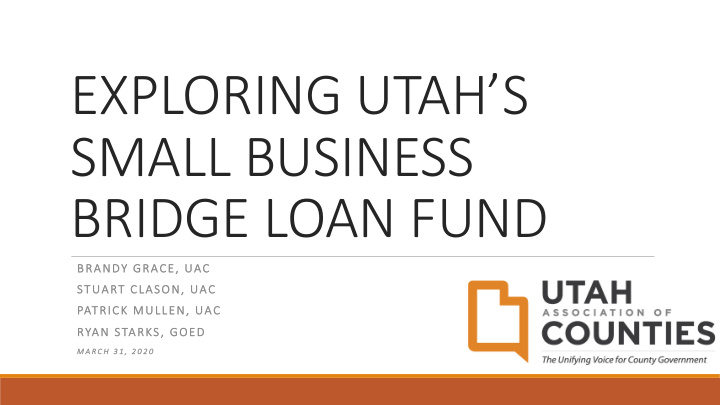



EXPLORING UTAH’S SMALL BUSINESS BRIDGE LOAN FUND BR BRAND NDY G Y GRACE CE, U UAC C ST STUART CL CLASON, , UAC PA PATRICK MULLEN, UAC RY RYAN STARKS, GOED M A M A R C H 3 1 , 2 0 2 0
AGENDA • UAC Update on Economic Relief Resources Surrounding COVID-19 Pandemic • Utah Small Business Bridge Loan Fund • Terms • Criteria • Eligibility • Timeline on Review and Fund Disbursement • Upcoming Future Calls & Resources
UAC UPDATE • UAC has compiled a summary of economic relief resources for businesses and communities experiencing economic distress due to COVID-19 • UAC will be arranging future calls with agencies such as the SBA, EDA, SBDC’s, GOED, DWS and others • Topics will include how to access: • SBA relief loans, paycheck protection funding, CARES Act funding • EDA, CDBG, and USDA loans becoming available • Unemployment and workforce services relief • UAC Contacts: • Stuart Clason (Stuart@uacnet.org, 318-548-1337) & Patrick Mullen (Patrick@uacnet.org, 801-599-6647)
UTAH BRIDGE LOAN PROGRAM • Created by $8M in repurposed state economic development funds and $500K from DWS • GOED bridge loans to Utah-based small businesses impacted by the COVID-19 pandemic • GOED will use up to 25% of the funding for rural Utah businesses • Terms: • 50 or fewer employees • Loan amounts range from $5,000 to $20,000 • 0% interest for up to a 60-month period • Loan amounts shall not exceed three months of demonstrated operating expenses • Loan payments are deferred for 12 months
CRITERIA • Businesses must be established and licensed before January 1, 2020, and in good standing with the Utah Division of Corporations and Commercial Code (will be verified here). • Applicants must have employees on their payroll for whom they have had payroll taxes withheld (i.e., W-2 employees). • Applicants must provide six months proforma of estimated lost revenue or other documented loss evidence. • No collateral requirements. • Eligible loan uses include working capital to support payroll expenses, rent, mortgage payments, utility expenses, or other similar expenses that occur in the ordinary course of operations. • Receiving other forms of emergency funding will not disqualify an applicant from receiving loan funds through this program. Still, companies must disclose if they have applied for emergency funding from other sources.
ELIGIBILITY The business must demonstrate financial stress or disrupted Preference for funding will be given based on the following criteria: operations, which may include but are not limited to: • Businesses that have experienced severe economic impact due • Notices from tenants closing operations and not paying rent to the COVID-19 pandemic. caused by loss of income. • Businesses that can demonstrate a multiplier impact on other • Notice of inability to pay rent or make loan payments due to industries. reduced sales or suspended operations. • Businesses that play a key role within a strategic state supply • Increased costs related to COVID-19 prevention measures. chain. • Businesses that pay above-county-average wages. • Notice of disrupted supply network leading to a shortage of critical inventory or materials. • Businesses that employ full-time workers. • Businesses whose complete application demonstrates solvency • Other circumstances subject to review on a case-by-case before the current economic crisis. basis.
HOW TO APPLY The Following Information is Required • Financial statements: profit and loss, and balance sheet statements for the previous year, and most recent quarter or month. • Last year’s business state of Utah tax returns (2019 or 2018). • A copy of the business lease agreement or mortgage statement for the business location. • A copy of a current business license. • A copy of a Utah driver’s license or government-issued ID. • A completed and signed W-9 (W-9 information must match what’s on file with the IRS and the same address that will be used to mail bridge loan funds). • The previous year’s personal tax return (2019 or 2018) for any guarantor (owner with at least 20% equity in the business). • Six months proforma of estimated lost revenue or other documented loss evidence. • Contact information including principal name, phone number, email and mailing address.
CONCLUSION Q&A
Recommend
More recommend